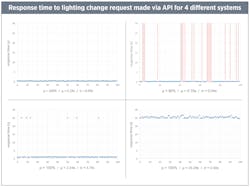One of the hottest areas of lighting is being facilitated by the convergence of energy-efficient LED technology with the rapidly emerging IoT. Not only are LED light sources inherently dimmable and instantaneously controllable, but they can be readily integrated with sensor and control systems to enable even further energy savings — as much as 1974 tBtu annually in the US, according to a recent DOE report — through the use of such features as occupancy sensing and daylight harvesting. So it’s not surprising that increasingly, lighting systems are incorporating network interfaces and sensors to become data-collection platforms that have the potential to carry out advanced adaptive lighting strategies.
Related: Strategies in Light keynotes will enlighten the industry on emerging opportunities
But the abundance of these new possibilities, combined with a lack of standards and precedents for such a revolutionary lighting use, calls to mind the “Wild West” climate that reigned a decade ago, when LED lighting was still in its early days. To address this, DOE has created a connected lighting test bed (CLTB) designed to characterize the capabilities of connected lighting systems. The first study carried out in the CLTB focused on interoperability as facilitated by application programming interfaces (APIs). It explored the diversity of such interfaces in several connected lighting systems, characterized the extent of interoperability they provide, and illustrated the challenges, limitations, and tradeoffs encountered.
The study characterized the system architectures and the API structure, nomenclature, and information models; investigated the development of a common integration platform; and simulated two real-life use cases to illustrate the relative effort required to use APIs to enable new features and capabilities facilitated by information exchange. The goal is to provide feedback to technology developers on the capabilities and limitations of currently available APIs, educate potential connected lighting system owners and operators as well as IoT stakeholders, and accelerate the development of interoperability specifications, standards, and frameworks or platforms. Part 2 of this initial study will focus on improved testing and characterization methodology.
Related: US DOE publishes Lighting Market Characterization documenting SSL march
A second CLTB study investigated energy losses in Ethernet cables used between Power over Ethernet (PoE) switches and luminaires in PoE connected lighting systems. A test setup comprising a PoE switch, a set of luminaires, and a reference meter was used to test nine cable models of varying design. Power measurements for two widely differing cable lengths — one near 50m and another near 0m — were used to determine the portion of PoE switch output power dissipated by each cable model. The results were analyzed to explore the impact of cable selection on PoE lighting system energy efficiency, as well as the effectiveness of guidelines recently introduced by the American National Standards Institute (ANSI) C137 Lighting Systems Committee. The key finding is that the guidance offered in ANSI C137.3-2017 does appear to be effective in limiting cable energy losses to 5% in PoE lighting applications, provided that the average cable length on a project doesn’t exceed 50m.
JAMES BRODRICK is the manager of the US Department of Energy Lighting program, directing solicitations, portfolio management, strategic planning, and quality performance.








